Clown History
History of Clowns
The history of clowns is a vast subject and one could write a book about it if one had time! Luckily, there have been others with the willpower! There have been several good books on the subject, notably “Clowns” by Douglas Newton; “Bring on the Clowns” by Beryl Hugill; “Clowning Through” by Frank Foster and “Clowns & Pantomimes” by M. Willson Disher to mention just a very small selection. I have used several in my research for this article and I acknowledge the authors with gratitude! Please see my Bibliography at the end of this article.
So, where did clowns originate from? Right through ancient history there have always been men (and women!) who have had the ability to make others laugh. Sadly, in ancient times, only records of great deeds, battles and momentous decisions were recorded and passed down; the ‘doings’ of every day folk were lost in time. However, ancient clowns did exist – not known as clowns, of course – the word clown not coming into use until the 16th Century.
Ancient Egypt 5000 years ago used to keep African Pygmies known as Dangas in the Royal Courts to amuse the Pharaohs and Royal Families. They dressed in leopard skins and strange masks and danced and imitated the Egyptian Gods, such as Bes – the God of Dance and Battle.
Ancient China had clowns attached to the Imperial Court as long ago as the Zhou Dynasty (1046-256 B.C.). One is named as Yu Sze, who was clown to Ch’in Shih Huang-ti, who built the Great Wall of China.
Ancient Greece had clowns who wore short tunics (“chiton”) which were grotesquely padded at the front and rear and knitted socks like tights. He had an exaggerated artificial phallus strapped around his loins (remind you of anyone? – perhaps it was the Ancient Greek equivalent of “medallion man”?).
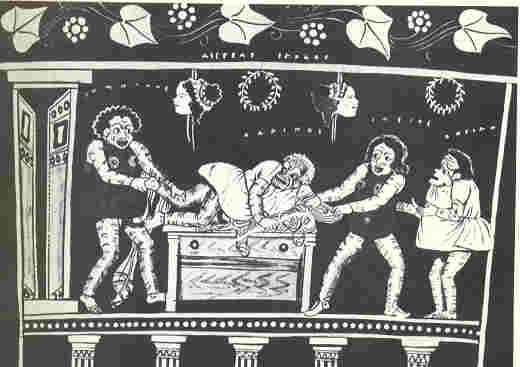
Clown Bluey’s History of Clowns: Ancient Greek Clowns from the farcical plays called Phlyake (Mansell Collection)
Ancient Rome had several types of clown. Some were known as Sannio – they were a popular type of mime and famous for their ability to pull hilarious grimaces with their faces and body. It follows that this clown, unlike most others of this time, did not wear a mask. Another clown was Stupidus (hence our word stupid) which was Latin for mimic fool. He was usually bald-headed or wore a long pointed hat and a multi-coloured outfit (surely the predecessor of Harlequin?). He mimicked and “sent-up” the more serious actor. He was famed for his innuendo and riddles and the ability to rain down blows on his fellow performers in burlesque fights in typical slapstick fashion. In true clown style, he used scandals of the day for his material and nothing was too sacred or sacrosanct to be the focal point of his humour. There was also a lower form of clown who was known as Scurra (from whence comes scurrilous), who indulged in jesting, his physical oddities setting him apart from his better class colleagues. There were yet others known as Moriones (moron) whilst the mentally retarded were known as Stulti and Fatui. It was common for the great houses and the courts to “keep” freaks and fools, who on the whole were treated kindly. It was thought by many that they were endowed with special powers from the Gods and were treated as good luck charms. During the Festival of Saturnalia which marked the shortest day and the rebirth of life, a lowly slave would be chosen to take the place of the master of a household and for the duration of the Festival, he would “rule” the household. This is the origin of the “Lord of Misrule” tradition at the Medieval Christmastide.
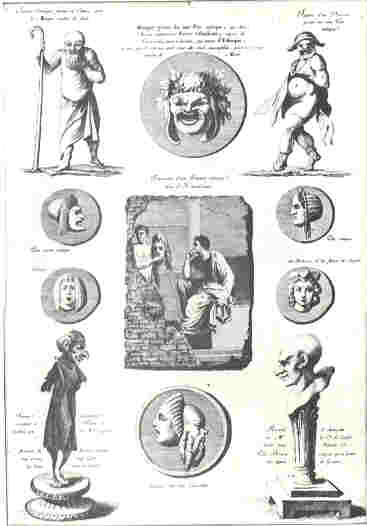
Ancient Roman Theatre using masks (BBC Hulton Picture Library)
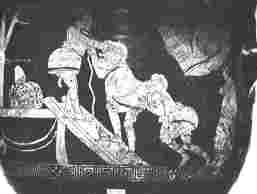
Ancient Roman clowns in the 4th Century (Mansell Collection)
In Malaya, clowns exist today who are similar to ones who performed thousands of years ago. They are called P’rang and wear huge masks and turbans as big again as themselves.
A well known clown existed in Turkey in about 1440 who, through the ages has become a cult and folk hero, with many coarse and “tall” stories about him. His name was Nasr el-Din who was court jester to Tamburlaine (or Timur) the Mongol Conqueror. Nasr el-Din was famous for his cunning, naivety, buffoonery and shrewdness; he loved to score off other people and play practical jokes. To learn more about this mischievous comic, read “An Eastern Chequerboard” by Sir Harry Luke.
Just a short glimpse to cover many centuries in the past but as we emerge into the era of modern history, the records improve and we begin to see real people with recorded names who were famous clowns of their time. In particular, there were the Court Jesters. By the 14th Century, the professional funnymen had taken the place of real fools in many Royal households Unlike their predecessors of course, the Jesters could provide humour on demand.
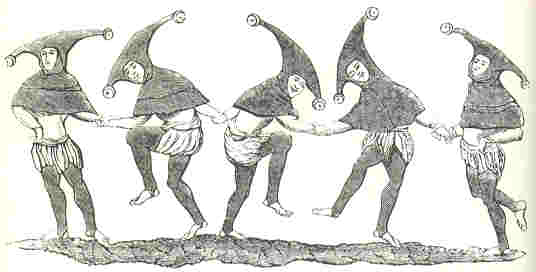
Jesters from a 13th Century manuscript (BBC Hulton Picture Library)
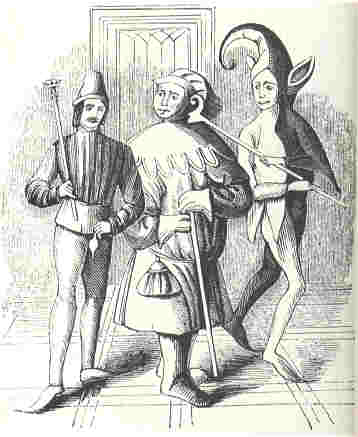
A court fool and a buffoon from a 13th century manuscript (BBC Hulton Picture Library])
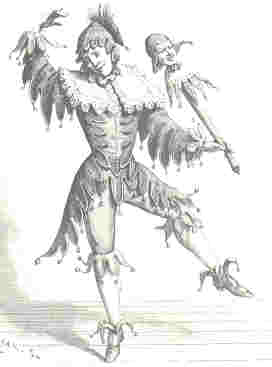
19th century impression of a Jester (Mary Evans Picture Library)
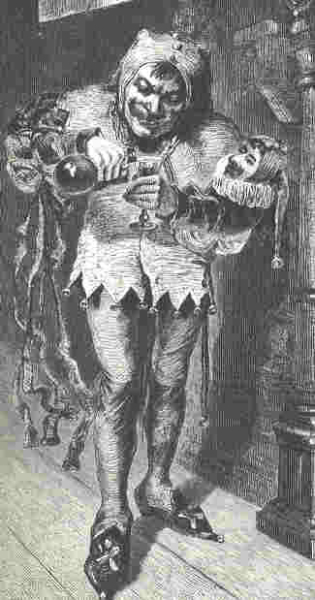
A 19th century impression of a court jester (Culver Pictures Inc.)
In a time when printed material was not freely available (and most people were unable to read anyway) the Jester represented the principle of free speech in an age where such freedom hardly existed for anyone else. Their closeness to the throne gave them considerable power which made them enemies as well as friends in court. Archy Armstrong, Jester to Scottish Stuart Kings James I and Charles I seemed to have been universally disliked by everyone apart from his employers but earned enough during his career to retire as a moneylender and landowner. Others seemed to have been well liked. William Summers, Jester to King Henry VIII won universal adoration. His picture hangs in Hampton Court Palace and he was dubbed “the poor man’s friend” because of his kindheartedness. Considering how many people Henry beheaded, William did well to keep his head and outlive his master!
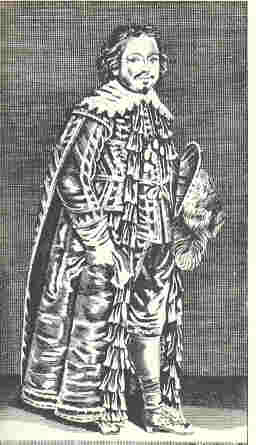
Archy Armstrong, Scottish Stuart jester to James I of England and Charles I
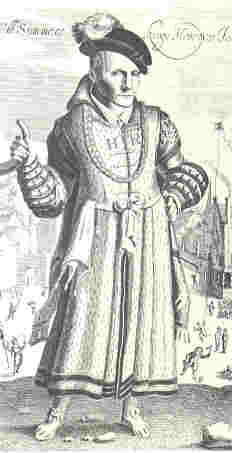
Will Sommers, jester to King Henry VIII (Mary Evans Picture Library)
John Scogan was Jester to King Edward IV and was unusual in that he was an Oxford scholar. He was famous for his roistering, roguish, irreverent personality whose maxim was “a merry heart doeth good, like a medicine”. He loved practical jokes. However, one became his undoing, He had borrowed a large sum from the King and on the due date for repayment he did not have the money. He decided to play dead and arranged for his friends to dress up in funeral outfits and carry him in a bier. They entered into the joke with glee. In due course they came across King Edward who was very sad at the loss of his Jester and made many kind remarks and said he forgave Scogan and his relatives the money owed. On hearing this, the “dead” Jester leapt up and thanked his gracious King for his act of grace saying, “It is so revivifying that it has called me to life again”. Edward promptly banished him to France!
Another well-remembered Jester was Rahere, Jester to the English Court of Henry I in the early 1100’s. On a pilgrimage to Rome he became ill with malaria and pledged that if he survived he would build a hospital for the poor. He kept his word and built a great Priory and Hospital at Smithfield named in honour of St Bartholomew. The Priory was later dissolved by King Henry VIII but the Hospital is still in use today: “Bart’s”, the famous teaching hospital.
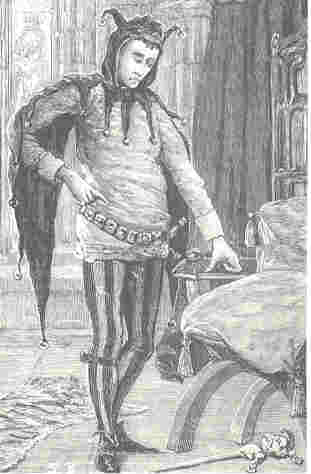
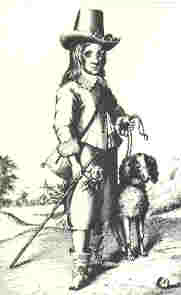
(L) Rahere, jester to Henry I and Queen Matilda in the early 1100’s (Mansell Collection)
(R) Jeffrey Hudson, 18″ high dwarf Jester to Charles I and Queen Henrietta Maria (Mary Evans Picture Library)
The very last Jester in private employment in England was Dickie Pierce, a Fool to the Earl of Suffolk. When Pierce died in 1728, aged 63, he was buried in Gloucester, his epitaph penned by no less a person than Jonathan Swift.
On the continent, Jesters held sway for longer than in England. Italy had a number of worthy Jesters and Germany had its “Merry Counsellors”, whilst France was famous for its celebrated Jesters. Charles V employed Mitton and Theverin de St Léger whilst Louis XIII had l’Angely. Brusquet was attached to Henry II and Louis XII employed Triboulet (who is the hero of Hugo’s “Le Roi s’amuse” and Verdi’s “Rigoletto”).
In the East, a strong tradition of Jesters existed and indeed goes back further than that of Europe, certainly as far as the 8th Century. The great Caliph Haroun al-raschild, a builder of the Taj Mahal had a Jester named Bahalul who concealed wit, vivacity and observations under a cloak of simplicity. When asked by Caliph to procure a list of all the fools in Baghdad, Bahalul replied, “That would be difficult, oh Commander of the Faithful, but if you desire to know the wise men, the catalogue may soon be completed!”
Eventually, custom, taste and economics conspired to sweep the Jester away and in any case, similar in many ways as the Disciples are, it is not from the court Jesters that our modern clown is descended. They come from the public jesters, street entertainers, actors, pantomimists and masquers who followed.
One of the earliest uses of the word “Clown” occurs in one of Shakespeare’s plays. Everyone knows and misquotes, Hamlet’s speech, “Alas poor Yorick…” – fewer realise that the gravedigger who so casually passes the relic to Hamlet is, in the play, designated “Clown”. The term means “Clod” or “Clumsy, boorish fellow” and is thought to derive from the old Danish word “Klunni” which conveys the same meaning. It perfectly describes the character of the gravedigger, discussing the details of the rotting corpses and throwing bits of them about, but it is far from the modern use of the term “Clown” which indeed was not used in its modern sense for another one hundred years.
In the 1700’s, Italian Commedia del’arte al improviso (professional improvised comedy) was imported into this country. In the earliest forms of this entertainment, actors improvised, from a vast memorised storehouse of line-combinations and business, a play along a simple theme. Two young lovers are trying to elope and they are constantly thwarted by the girl’s father (Pantaloon) and his friend the Doctor (both old men). Skirmishing around this quartet are a number of extra characters, including soldiers (Scaramouche, the Captain) and servants, Zannis (hence our word Zany). By the time the pantomime arrived in Britain, Harlequin and Columbine were the two young lovers. Pantaloon was a figure of fun and a nuisance. Policemen had replaced soldiers, Pulchinello had transmuted into Punch and got his own show, and Pagliaccio had gained the sobriquet “Clown” and was the knockabout interest. Harlequin was given a magic bat so that he and his lover could transform scenes magically to escape the pursuers during the hectic, mad chases. He would “slap” the stick and so it was later comedic scenes became known as “slapstick”.
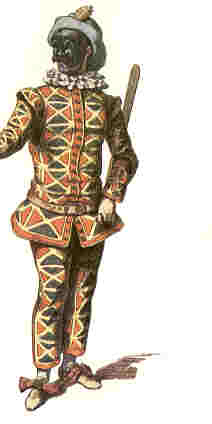
Commedia dell’arte: Arlecchino, the original Italian version of Harlequin in 1671.
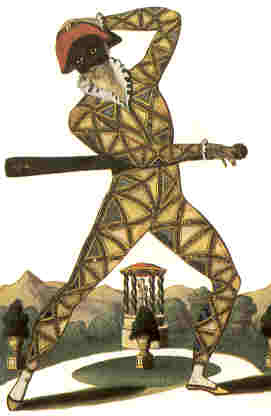
Commedia dell’arte: 19th Century actor Tom Ella playing Harlequin (Mary Evans Picture Library)
In 1778, there was born a man who, by his own personality, skill and sheer hard work was to snatch the Harlequinade away from the Harlequin and hand it firmly to the Clown. The man was Joseph Grimaldi and even today, all clowns are nicknamed “Joeys” in honour of Grimaldi. He it was who first did away with the pantomime mask and wore make-up, a practice soon seized upon and copied by his contemporaries.
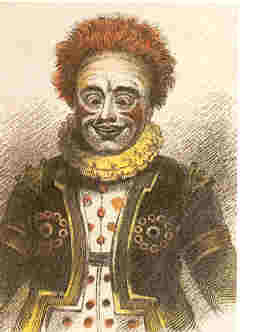
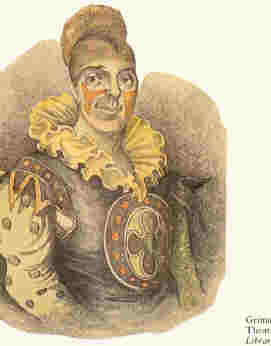
Joseph ‘Joey’ Grimaldi: (left): Wearing original costume which ‘sent up’ dandies of the time (right): Grimaldi’s better known motley
Prior to this, in 1768, Philip Astley opened his Amphitheatre, the first “circus”. Although Philip Astley has been attributed to inventing “circus”, entertainment in the form of gladiators fighting and other entertainment have been recorded in ancient Rome from 186 B.C. in amphitheatres such as the one shown in Pompeii. Ancient Rome also had ‘clowns’ although they were not known by that name.

Ancient Roman amphitheatre at Pompeii
The word “circus” is Latin for “ring” or “circle”, and has referred since its earliest usage, some two and a half millennia ago, to popular entertainment of a non-narrative and highly physical variety, performed outdoors or under a great awning in a circular field surrounded by rising seats. The substance of the performances has changed over the centuries just as society’s idea of what constitutes good entertainment has undergone a profound shift from the dire and cruel to the daring and light-hearted.
The greatest circus venues of ancient times were the Circus Maximus, which showcased perilous chariot racing, and the Colosseum or Coliseum, a showcase for lethal gladiatorial combat.
“The Roman circus was a round or oval structure with tiers of seats for spectators, enclosing a space in which the races, games, and gladiatorial combats took place. The games, aside from races, were brutal and bloody, and for this reason the Greeks, even under Roman domination, never really accepted the circus.”
– Columbia Encyclopedia: circus
“A third of a mile long and 150 yards wide, the Circus Maximus allegedly held 250,000 people. The remains suggest that there may have only been 150,000 seats there; however, these people had come from all over the empire to watch these races, sometime over great distances. To turn anyone away would surely incite a riot. Presumably a large number stood, and a greater number sat on the hills surrounding the circus. That these Romans would go so far out of their way to watch horse races begins to hint at the depths of their obsession, which, like most public obsessions, was not shared by all. The wise and judicious ruler would notice that even though the public redressed their grievances, they shut up when the horses came out. “Reward the restless with entertainment, and they’ll leave you alone.”
– History House: “Circus Maximus: Rome’s Astrodome” (historyhouse.com/in_history/circus_maximus).
“The Coliseum had a canvas roof – the velarium – raised and lowered by a specially trained team of Roman sailors known for their skill with rigging ships. The canvas “big top” had a large hole in the center to admit more light.
“The Coliseum’s spectator capacity was about 50,000 person—dignitaries, their guests, their slaves, a select number of common people, and “foreigners”—people who did not hold Roman citizenship. Commoners, slaves and foreigners were seated right under the canvas roof, where it was hottest.”
– Crystalinks: Ancient Roman Architecture (crystalinks.com/romearchitecture.html)
Many thousands of slaves and animals were required annually to sustain a Roman circus. The long and arduous journey to the ring, undertaken forcibly and often including a Mediterranean sea passage, was, for these poor souls and miserable creatures, a one-way affair. Today, we think most often of the circus as a travelling company of skilled performers and trained animals who not only arrive in town but also, after some days of spectacle and provisioning, take to the road again. This idea was not formalized until recent centuries, for entertainments of the kind did not take place on an important scale between the fall of the Roman Empire and the beginnings of the Industrial Age.
Nonetheless, the travelling performers of the Middle Ages form a link between the grand, sadistic circus games of decadent Rome and the itinerant acrobatic spectacles of a newly energetic Europe. Conventional minstrels and actors as well as jugglers, jesters, bear baiters and conjurers travelled alone or in small groups between medieval towns, taking advantage of market days to draw a crowd from whom they hoped to elicit donations commensurate with their skill. These mobile entertainers lacked the professional management and infrastructure of the later true circuses, but they were forerunners of the circus art. They are still with us today in the form of buskers who entertain us in subway stations and on pedestrian promenades.
“In the Middle Ages and Renaissance, the main performers of music were the minstrels or bards, singing ballads and telling epic tales wherever they went. Many courts had a different sort of entertainer as well, a jester or fool, whose role was to amuse the gentry. Oftentimes there were theatre performers, puppeteers, and even acrobats who would travel and earn their way by performing.”
– Redwall Troupe: Entertainers
“Mountebanks, jugglers, conjurers and minstrels of the Middle Ages amused the aristocracy. Many of these performers were also travelling “street buskers.” They frequented the market places and entertained the ordinary folk. The commedia dell’arte of the 1600’s in Europe marked the first appearance of companies of professional entertainers.”
– History and Origins of the Side Street Circus
Early Circus in Britain
According to widespread consensus, the first rigorously organized circus since Roman times was established by Philip Astley, an English cavalryman who went into show business after returning from service in the French and Indian Wars of North America. His trained horses and agile riders performed equestrian tricks in a ring before a paying audience. The horsey entertainment gradually diversified into acrobatics, comedy, and dancing dogs.
“The first modern circus in Europe premièred on the south bank of the Thames close to Westminster Bridge in the late 18th century. Philip Astley (1742-1814) was the son of a cabinet-maker from Newcastle-under-Lyme in Staffordshire. At 17, he joined Colonel Eliott’s Fifteenth Light Dragoon Regiment, then rose to become sergeant major and served in the French and Indian War in what is now Canada. Along the way, he developed his skills as a rider.
“In 1768, he opened a riding show in south London: teaching in the morning, trick-riding in the afternoon. He did his shows in what he called a “circus”: a round performance area ringed by seats. The tightness of the circle (42ft in diameter) was perfect for creating the centrifugal force that kept him on his horse during more creative manoeuvres. It is still the standard diameter used today.
“After a couple of years, jaded London crowds wanted something new, so Astley threw in some jugglers, a clown or two, a few tumblers. Faster than you can say “Ladies and Gentlemen”, the modern circus was born. Astley performed at Versailles for Louis XV and soon established circuses on the Continent.”
– The Independent: The complete guide to the circus
It is acknowledged that Astley was the first to realise that a 42 metre circumference ring was the best measurement for a horse to canter around, the centrifugal force generated allowing the rider to perform tricks. As an ex-Cavalry Officer and an expert horseman, Astley at first concentrated on riding skills and tricks. However, he soon realised he needed other things to amuse the patrons and clowns and other entertainers were soon employed. The first clown was Mr Merryman, by which name he was always ceremoniously addressed in the ring. His costume was an ornamental doublet with frilled collar, striped hose and a perruque wig topped off with three peacock feathers. It was not long before all Astley’s Merrymen copied Grimaldi and wore a white-based make-up with the expression painted on in red and black. Mr Merryman engaged in crosstalk with the riders and the Ringmaster, his fine clothes not lending themselves to knockabout or robust comedy and this is borne out by a note scribbled in Astley’s hand on a prompter’s plot: “The Clown to interpret and articulate better”. This would seem to be the first record of a Circus Comic being referred to as a Clown.
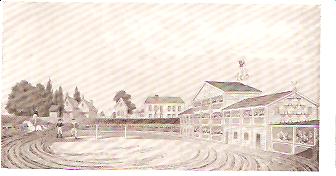
Astley’s first circus, 1768.
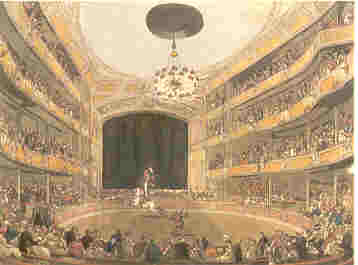
Astley’s Circus as it looked in 1812 (Mary Evans Picture Library)
Other circuses soon flourished. In Batty’s Company was Dick Dewhurst, billed as “Principal Elocutionist of the Grotesques and Buffoons” which indicates that there were several clowns. Here is a sample of Dewhurst’s ditties which will strike chords in many of today’s modern clowns!:
Call me Mr Merryman!
Worn are my clothes almost out
By being whipped and knocked about;
torn is my face in twenty places
By stretching wide to make grimaces.
My worthy cits, (citizens)
Now it is fit
That you should sit,
Gallanting it,
The whole kit,
In box and pit
To see me hit,
Boxed, cuffed and smit,
Sham dead as a nit,
And laugh at it,
Till your sides split?
There you sit,
Through requisite
To rack my wit
These rhymes to knit,
Which I have writ,
To bring the folks to a house well lit,
For a great attraction all admit
Will be on Dewhurst’s benefit.
From these white-faced circus clowns and Grimaldi’s Pantomime Clowns, emerged the modern Whiteface Principal Clown, the Boss Clown, in sequins and conical hat and graceful shoes; he who shines at everything, whether it be playing musical instruments, juggling and spinning plates or leading the other buffoons in traditional clown entrées.
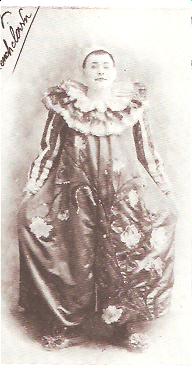
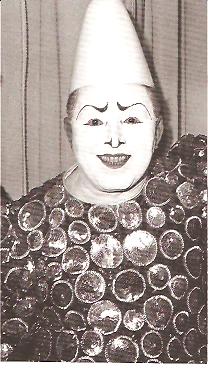
(left) The Whiteface Clown: O’gust, an early 19th Century clown; (right) Kiko from The Fratellinis
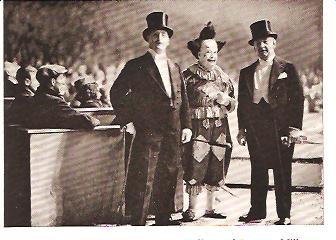
“Whimmy” Whimsical Walker with Willy Schumann and Bertram Mills in the 1930’s
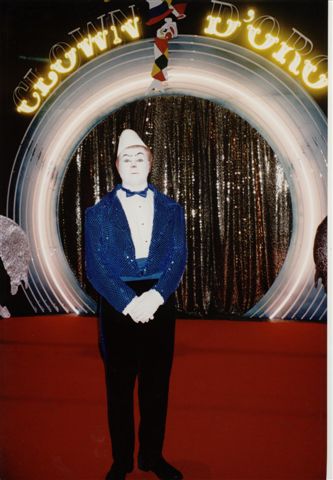
Jean Barrel, of ‘Lockstock & Barrel’, a modern 20th century Whiteface
But what of that other fool, the one with the large red nose, baggy pants and huge boots, the one called the Auguste Clown?
The Whiteface clown held sway in the circus for a hundred years, but as we progress into the 20th Century, he became less of the funster, giving way to the cheeky Auguste. The Whiteface Clown’s wit and skill were still important, but now he was content to use them as a foil or straight man to the zany undisciplined knockabout of his bizarre colleague. But another type of whiteface continued to shine: the Mime. He emerged from the commedia dell’arte, pantomime and French clown Perriot. Probably one of the most inspired and famous mimes is Frenchman Marcel Marceau, his clown being named “Bip”.
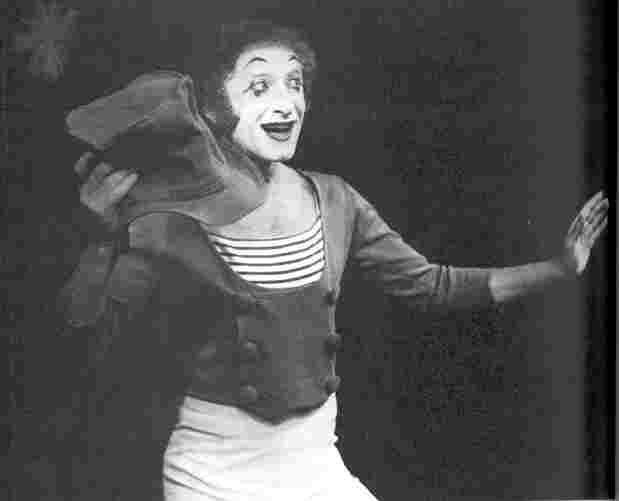
Whiteface Clown – Mime: Frenchman Marcel Marceau as”Bip”
The Auguste appears to have made his appearance in the middle of the 19th Century and many tales are told of his origin. It is mooted that the famous English Clown, John Albert Griffiths who worked under the name of “September” always called his partner, no matter who that was, August, and the name has stuck.
However, there is no doubt that everybody’s favourite (though possibly legendary) tale concerned a young apprentice clown called Tom Belling, who was serving his apprenticeship with the well known German Circus Renz. Renz was known as a typical employer of the time who would beat his apprentices should they step out of line. When Renz’s Circus was in Berlin, Tom angered his boss and was ordered to stay in his quarters for four weeks. As boredom crept in, Tom experimented by juggling with an old wig. He tried in on backwards and found it looked ridiculous. He turned a large coat inside out and put it on, plus a pair of somebody else’s too large boots. When his young fellow apprentices saw him, they laughed uproariously and bet him that he wouldn’t dare enter the Big Top. Tom set off, keeping an eye out for the dreaded Renz. Just as he was peeking through the ring doors, Renz came behind him and gave him a violent shove which catapulted poor Tom into the centre of the ring, where he collapsed in a heap.
The audience were delighted with this strange apparition and as the terrified Tom scrambled to he feet, he tripped over the large boots, resulting in the audience howling with laughter. Someone shouted out, “Auguste! Auguste!”, which in German slang of the day meant something like idiot/fool. Poor Tom wheeled around with a look of hurt and this appealed to the audience even more and soon the cry of “Auguste, Auguste!” was on everybody’s lips. Terrified and ashamed Tom tried to rush to the safety of the curtain, tripped over the ring entrance and finally fled from the ring, followed by gales of laughter and applause. He ran straight into the arms of Renz who was shaking and quivering, not as Tom first thought with rage, but with laughter. Renz knew a good thing when he saw it, and so Tom Belling became an Auguste from that day on.
It is a nice story, although some historians refuse to accept it as possibly being true as they point out that in colloquial German, the term “Dumme August” means something akin to “Zany” or “Addlepate”, and is now sometime used to mean “Clown” in phrases like “Clowning around”, which comes out as “playing the dumb Augustus”. It does seem odd that a German crowd should suddenly drop the “Dumme” and shout the French form of “August”, but it’s still a great story!
Having appeared on the scene, however, the Auguste was here to stay and there have been many great Auguste clowns who have “put on the motley and slap” and trod the sawdust. In the 20th century, great Augustes have included the great Swiss Clown, Grock, the (Russian) Latvian Clown, Coco (Nicolai Poliakov) who was adopted and became an honorary Englishman and honoured with an M.B.E. and Spanish Clown Charlie Rivel.
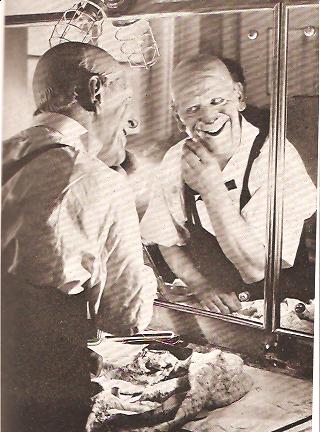
Grock makes up
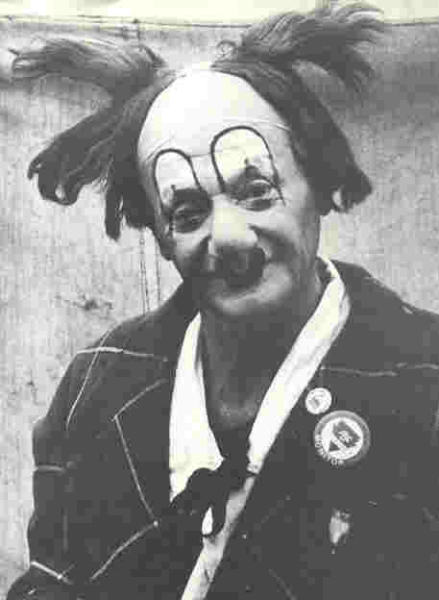
Coco with ‘fright wig’ (BBC Hulton Picture Library)
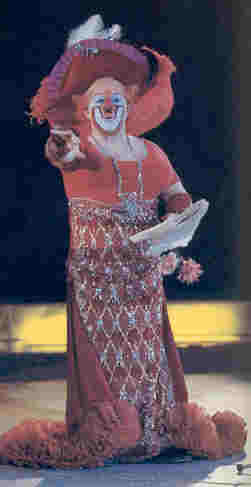
Charlie Rivel as a ‘Diva’ (Kurt Scholz)
Others that spring to mind are the French Clown Charlie Cairoli who clowned at Blackpool Tower Circus in Britain for over 30 years, Popov, a truly great Russian clown, Dimitri, Pippo, Doodles and the French Fratellinis.
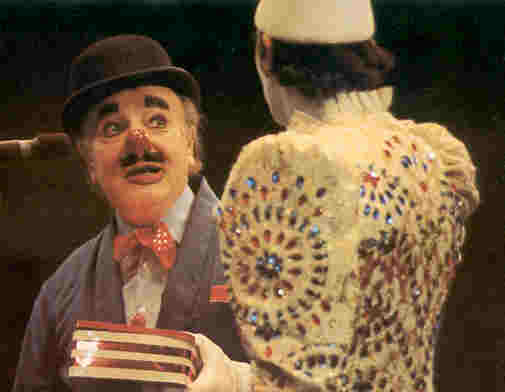
Charlie Cairoli with Whiteface son ‘Paul’
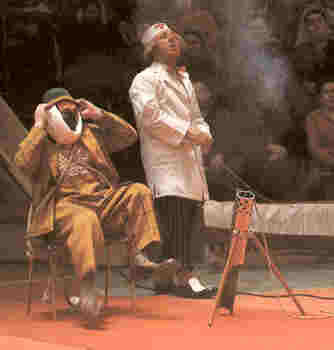
Popov from Russia performs the Dentist Entrée
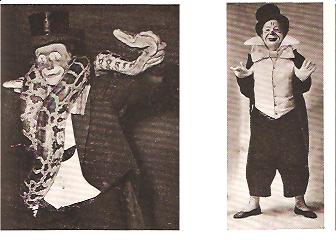
(left) Pippo with snake. (right) Scottish clown Doodles
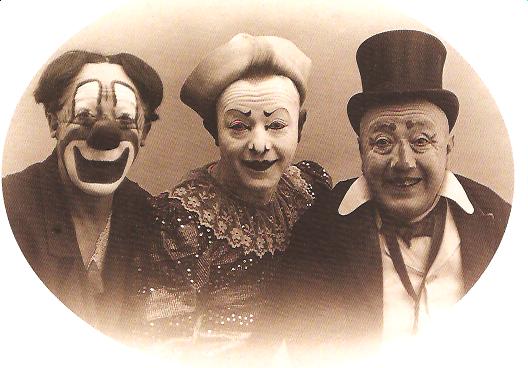
The Fratellinis – Albert, François and Paul
There have been other fairly ‘recent’ developments for clowns as well. In the United States, “hobos” or tramps roamed over the countryside, travelling illegally in freight trains. It wasn’t long before comedians copied their ‘tramp’ look and the hobo clown was born, the only clown character to evolve in America. Emmett Kelly was a famous American Hobo Clown.
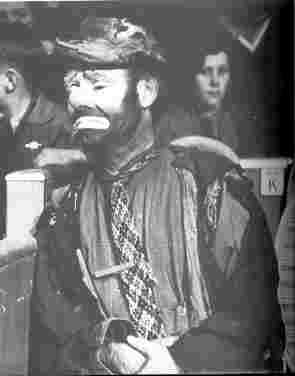
Emmett Kelly, famous USA Tramp/Hobo clown (BBC Hulton Picture Library)
In the great depression of the 1930’s, unemployment and homeless people recorded an all time high. From this, the European Tramp Clown appeared. Charlie Chaplin was probably the first and best remembered. He travelled from England to America at the turn of the century, just in time to take advantage of the new medium of filming: The invention of the cinema in the 1890’s gave clowns greater scope than they could have previously imagined. Skills learned in the circus, the music halls and their American equivalent, vaudeville, were adapted to the screen. Cinema Clowns:
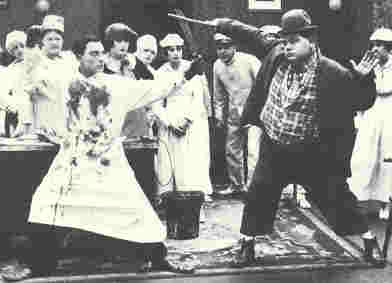
Buster Keaton & Fatty Arbuckle in “Good Night Nurse” 1918 (Culver Pictures Inc)
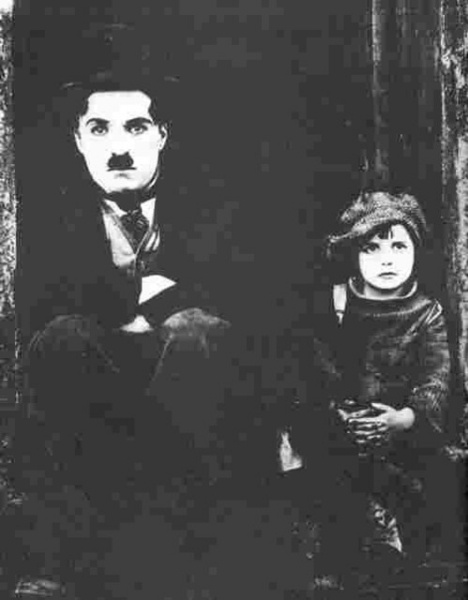
Charlie Chaplin and Jackie Coogan in “The Kid” 1920 (Finlar)
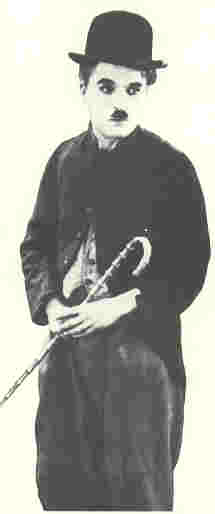
Charlie Chaplin in typical pose in “The Goldrush” 1925 (Culver Films Inc.)
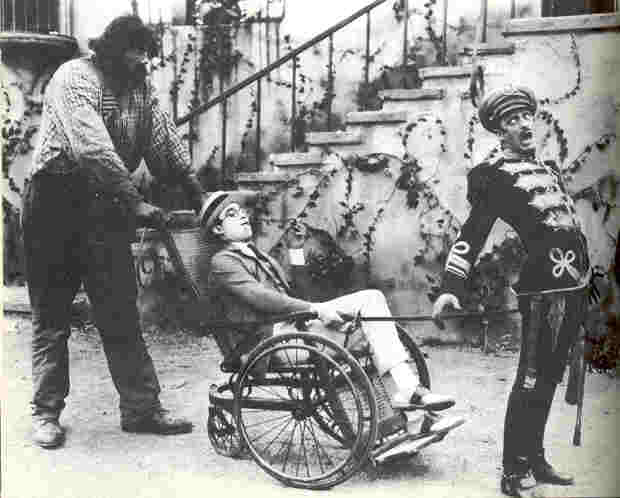
Harry Lloyd (centre) in “Why Worry” 1926 (Finlar)
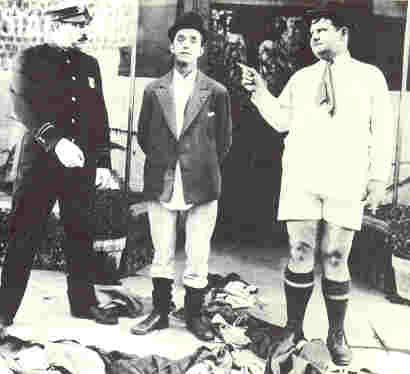
Laurel & Hardy in “You’re Darn Tootin'” 1928 (Culver Films Inc.)
Prior to the Second World War, most clowns in Britain found employment in the great circuses of these times, e.g. Bertram Mills Circus, Billy Smarts Circus and Chipperfields Circus. After the War, the larger circus’s struggled and clowns had to find additional avenues of work: summer Galas and Fêtes; shopping complex promotions; Children’s Parties; Concerts; Stage Shows and for a lucky few, television. I believe that there are more circus’s on the road now than there ever was before the War, but on the whole they are smaller and only employ one or two clowns, not the great groups that were the trademark of circuses like Bertram Mills. Ringling Bros Barnum and Bailey Circus units in America still employ large giggles of clowns, but usually as run-in or carpet clowns, not as principal clown acts.
In 1946/47, clowns working the great Annual Circus Christmas Show at London’s Olympia encouraged by circus enthusiast, Stan Bult, got together and formed the very first international organisation for clowns in the world: the International Circus Clowns Club. It was Stan Bult who started, as a hobby, to draw clown’s ‘slap’ (make-up) on to blown chicken eggs and since that time it has become a recognised tradition of registering and copyrighting both a clowns facial make-up design and a clown’s name, although china pot eggs have replaced the fragile chicken egg! The famous Collection of Clown Eggs can be seen in the Clowns International Clowns Museum. Because of the very nature of clown’s occupations, the club only met usually once a year, during the Christmas Circus season, when they held their annual meeting and also attended a clown church service to give thanks for the gift of laughter and to remember Joseph Grimaldi, and pay their respects to any clowns who had passed away during the previous year. This annual Clown Service continues to this day, and is always held on the first Sunday of February at the Clowns Church, The Holy Trinity Church, Beechwood Road, Dalston, East London at 3.00 p.m., to which the public are invited to attend. It was from the International Circus Clowns Club, that Clowns International evolved. But more of that below, for those interested.
Clowns continue to entertain all over the world. Whilst circus is still very strong on the continent and America, British clowns have continued to adapt away from their traditional circus roots and clowns in the 21st Century have continued to find employment in other public spheres: you will find them performing at children’s party’s, in shopping malls, in libraries, in churches, in hospitals, at fêtes and galas, at weddings, at Christenings, in schools and even in Prisons!
And long may the red nose and large floppy boots continue to provide laughter, chuckles and giggles!
Bibliography:
Beryl Hugo, Bring on the Clowns, 1980;
Clarke John S, Circus Parade, 1936
Disher Willson, Greatest Show on Earth, 1937
Foster Frank, Clowning Through, 1937
Grock, Grock, 1957
Mills Cyril Bertram, Bertram Mills Circus, 1967
Newton Douglas, Clowns, 1958
Poliakov, Nikolai, Coco the Clown, 1940
Poliakov, Nikolai, Behind My Greasepaint, 1950
Popov Oleg, Russian Clown, 1970
Rivel Charlie, Poor Clown, 1971
Serrault Michel & Levy Pierre, Les Fratellini, 1997
A further History about Clowns can be found at Wikipedia
Further reading
· A Ring, A Horse And A Clown – John H. McConnell
· Behind My Greasepaint – Coco
· Bert Williams – A Biography of the Pioneer Black Comedian – Eric Ledell Smith
· Bring On The Clowns – Beryl Hugill
· Clown, My Life In Tatters and Smiles – Emmett Kelly and F. Beverly Kelly
· Clown Performance in the European One-Ring Circus – K. Little, Culture, 1981. 2(1):61-72.
· Clowning… or Cloning? – Garrett Thomas
· Clowns – Douglas Newton
· Clowns – John Towsen
· Clowns Of The Hope – Tradition Keepers and Delight Makers – Barton Wright
· Commedia Dell’Arte; An Actors Handbook – J. Rudlin
· Don’t Be Clownin’ Around – Kayla Alberstett
· Felix Adler – Anne Aull Bowber
. Fools and Folly – Barbara Swain (New York, Columbia University Press, 1932)
· Fools and Jesters At The English Court – John Southworth
· Greasepaint Matadors – The Unsung Heroes of Rodeo – Jeanne Joy Hartnagle-Taylor
· Grimaldi – King of Clowns – Richard Findlater
· Grock – King of Clowns – Grock
· Here Come The Clowns – Lowell Swortzell
· I’m In Love With A Clown Named Joe – Adam Clark
· In A Dark Place – Steven Shiverdecker. A book about a grotesque clown that terrorizes a small town.
· It – Stephen King
· Jest In Time: A Clown Chronology – Bruce Johnson
· Life’s A Lark – Grock
· Models and Mirrors: Towards an Anthropology of Public Events – D. Handelman
· My Poor Clown Friend – Scottie Pinker
· Poor Clown – Charlie Rivel
· Russian Clown – Oleg Popov
· Sociological work on the fool: Reality in a looking-glass -Anton Zijderveld
· Subversive laughter: Maxwell Henrie the pantless cowboy/clown – Ron Jenkins
. The Book Of Clown – George Speaight
· The Clown In Times (Volumes 1-6) – Bruce Johnson
. The Fool: his Social and Literary History (1935) – Enid Welsford
· The Fool and His Sceptre – William Willeford
· The Tramp Tradition – Bruce Johnson
· Woven Gods: Female Clowns and Power in Rotuma (book review)
· Violent J and Shaggy 2 Dope of the American horror-core group Insane Clown Posse (ICP) – Wikipedia
The Life and Times of Joseph “Joey” Grimaldi
[with thanks and acknowledgement to Mike George and The Theatre Museum for additional material.]
Pantomime had been a dramatic form in the London Theatre for decades, but by about the year 1800, it had reached a critical point in it’s development: the plot in pantomime had become little more than a brief prologue to a long kaleidoscope of action, whose complexities called for ever-increasing inventiveness on the part of writers and performers alike. The leading character, Harlequin, was sadly beginning to suffer the fate of all romantic heroes: he was becoming boring. He was losing all the good lines and all he could do, within the constraints of his character, was perform prodigious leaps and strike other characters and “props” with his magic bat which would initiate an immediate transformation of scene. Incidentally, Harlequin’s magic bat was a “slapstick”, and this is where the word slapstick originated from. However, with Harlequin leaping all over the stage, transforming scenes left, right and centre, there is obviously a limit to the variations that can be worked into this type of staging. A vacuum was developing and something or somebody was needed to fill it. Soon, however, there was about to appear on the scene an artist whose genius was to transform this spectacular knockabout form of entertainment, dominated by the character of Harlequin, into a vehicle of satire, dominated instead by the clown.
We must go back a little way first: back to a December night towards the end of the 1770’s, when an Italian immigrant pantomime actor of advanced years and bizarre habits, one Giuseppi Grimaldi was presented by his twenty-five year old Corps de Ballet mistress, Rebecca Brooker, with a son whom he named Joseph. True to his boast “Old Grim” had young Joey on the stage as soon as he could walk, at about two years of age, at Easter in 1781.
From then on the young lad played to his Father’s lead until the old man died. Joey was then nine years old, but already a veteran, able to turn his hand to stage work both before and behind the scenes, although the money he earned was barely enough to keep him and his Mother alive. In these dreadful times, where children slaving in workhouses for up to 18 hours a day was the norm, Joey slogged to support his family.
This hard apprenticeship lasted until, at twenty, Joey came to the attention of Charles Dibden, who took over the management of Sadler’s Wells Theatre, where Grimaldi, like his Father before him, had been working. Dibden was not only a theatre manager: he was a gifted writer of pantomime and he recognised the potential in his young employee.
Grimaldi got his first chance as clown in Dibden’s pantomime “Peter Wilkins, or Harlequin in the Flying World”, on Easter Monday in 1800. He played Guzzle, the drinking clown opposite Gobble, the eating clown. It seems rather strange today, when we, as clowns, abhor and ban the use of drink and tobacco when in motley, when these substances could very well have been part of the main plot in pantomime in the 1800’s! Gobble, the eating clown was played by Baptiste Dubois, a veteran of 40 years’ experience and Chief Clown of Sadler’s Wells Theatre. Within a year, Dubois, either through jealousy or simple acceptance of the inevitable, left the Wells and Grimaldi, at 21, was made Chief Clown.
Dibden wrote of Grimaldi: “As a clown, and singer of clown songs, I despair of looking upon his like again. I never saw anyone to equal him. There was so much mind in everything he did ….. Grimaldi was All Over Clown”.
Grimaldi continued as clown for some 24 years. During this time he married a Theatre Manager’s daughter who bore him a son. He usually worked the summer at Sadler’s Wells Theatre; then in winter at, first, Drury Lane Theatre, then at the Theatre Royal, Covent Garden. He was now able to command a much better salary – although his own modest assessment of his value would have netted him a far lower wage had not Charles Dibden’s brother, Tom, stepped in and negotiated the sum upwards. For poor Grimaldi suffered from those tearing doubts about his own ability that have bedevilled many a great comic, doubts which made his off-stage personality somewhat morose. He himself once said, as a pun on his own name, “I am GRIM all day, but I make you laugh at night!”
And make them laugh he did. Very few contemporary descriptions of his work survive, and those that do are rather short on detail, but from what little we know we can see what gave Joey his lasting place in the Hall of Fame was that one indispensable quality, style. The work of the clown in those days was fairly basic: rush about the stage; eat and / or steal large quantities of food; get drunk; beat up, belabour or pelt all and sundry including various members of the cast; sing a few comic songs. However to these basics Grimaldi brought an inimitable delivery and an inventive genius. It has been said of him that, “he could achieve more with one look than any of his rivals could with their most elaborate transformations”. He was known to his contemporaries as “The garrick of Clowns” and “the Michelangelo of Buffoonery”.
Rarely speaking – except to perform his famous songs – he could deliver a wealth of meaning with a cock of the eye or a wrinkle of his mobile nose. On stage, he commanded a far wider technical range than any modern mimic: he would stand, looking out at the vast, candlelit auditorium with ‘a thousand odd twitches and unaccountable absurdities oozing out of every pore of his clownish mask’. His eyebrows would go up ‘like a pair of umbrellas, or one would ascend and the other remain to superintend the wink’. His chin was unusually mobile; he could lower it suddenly with an alarming drop. The sight of his oven mouth was enough to convulse the audience: every limb of him had a language. Joseph Grimaldi was hailed as the greatest Clown of the British Pantomime. Under his influence the Pantomime became, as Leigh Hunt described it in 1817, ‘at present the best medium of dramatic literature’. Strictly an entertainment for adults, it became as topically allusive as did, at a later period, the Revue.
The invention of steam boats, of coaches, of gas for illumination, the evolution of commerce, voyages by balloon, the dilemma of the poor, the extremes of fashion and, especially, of dandyism, were all targets for the scathing wit of Grimaldi, who once said, “It’s all in my way you know. I play the fool to show others the absurdity of it”. As another critic of the time wrote, “Pantomime forms a powerful engine for striking sharply and rapidly at the monstrosities of our time”.
Joey the Clown was an acrobat, a juggler, a swordsman, a dancer, a singer and a mime. He could design and paint scenery, make props, arrange stage fights and choreograph dances. He also loved to garden, make shoes, do carpentry, invent conjuring tricks, play the violin, keep pigeons and collect butterflies.
He could invent “comic business” which would keep an audience convulsed with laughter for minutes on end, and his use of props was masterful. He would invent fantastic visual stage tricks such as creating a man out of vegetables from the Convent Garden Market, with which he then began a stage fight, the animated creature finally beating him off-stage. He made a chariot out of a cradle, using circular cheeses as wheels and dogs as horses. He once created a ‘parade’ by using beer barrels, tankards, filling funnels and a handsaw to create not only a row of “soldiers”, but also a horse for himself to ride at the head the “parade”. Live animals were another of his stock-in-trade: he seemed to be able to calm and use them all at will, even when, as on one occasion, a goose, two ducks and a pig were provided, newly bought and aggressively alive, from the local market.
The Pantomime which made his name in 1806 was Mother Goose. He had a genius for comic songs which were written especially for him and which were sold in shops and on street corners. One of Charles Dibden’s Pantomimes, “Bang Up!; or Harlequin Prime” in 1810 owed its success to a song made famous by Grimaldi in which he exploited his facial expressions. The song was “Tippity-Witchit or Pantomimical Paroxysms”. Another of his famous songs, which the audience always joined and sung with him was “Hot Codlins”.
Many stories survive about Grimaldi: there was the well-known one which took place during the Christmas of 1810. At the time he was appearing in two pantomimes each night at different theatres: the first at Sadler’s Wells and the second at Covent Garden. Not having time to change his costume between shows, he would have a coach standing by at Sadler’s Wells Theatre to take him to Covent Garden Theatre. One night the coach did not turn up and, unable to get another, he set out on a trot to Islington. People at once recognised him from his costume and make-up and began to run with him so that by the time he reached Holborn there was a crowd of several hundred people running with him. At Holborn, he managed to get a coach but his bodyguard of public fans stayed with him and ran alongside the coach. Having reached Covent Garden Theatre, those who could afford it packed into the gallery just in time to shout out as he appeared on stage “Here he is again!”
By one of the ironies that bedevil the art of the theatre, Grimaldi’s greatest years coincided with a falling off in theatre attendance. He had sunk his money into the theatres, and as the receipts fell, his income began to dwindle. Soon, to maintain himself, Joey had to perform at several theatres, once in 1819, achieving a record of a full performance at three separate theatres in one night. His health could not survive this sort of effort, and it began to give out late in 1819, stage hands having to be stationed in the wings to catch and support the agonised Grimaldi as he came off stage. Then in 1923 news circulated that he was being forced to prematurely retire because of illness. Notices of Grimaldi’s last performance went out to all and sundry:
To greet his friends, ere he retires
To rural scenes and Village Spires
Grim takes a night to say Adieu,
And thank his Patrons tried and true.
To find relief from many woes
He seeks retirement and repose.
But can he go – and cease to grieve,
Such zealous hearts and friends to leave?
Oh, no! For forty years they’ve backed him –
Till sickness and Old Times attack’d him –
Come then, on Monday, as above,
His heartfelt gratitude to prove.
His farewell, which must have been one of the very first tribute performances of modern times, was one of the most moving occasions in the history of the theatre for he was such a man much loved by the people. The stage was filled with his fellow clowns, including his son, to see him give his farewell performance and to hear him sing one last time, his most popular song, “Hot Codlins”.
In his retirement, before he became hopelessly crippled and had to be carried about on the back of a friend, he continued to write pantomime sketches which he used to send to friends still working as clowns. Below is an example of such a sketch that he wrote to his friend, Alfred Burn, on December 9th, 1836, just five months before he died. It is an interesting piece, if somewhat confusing, and relies on the Pantomime’s fast pace, and Harlequin’s ability to transform the scene immediately at the stroke of his slapstick. It is reproduced here as written: you my not be able to follow the period English! The scene is set outside in a street of shops, one of which is initially a pastryshop, however you will need to use your imagination as Harlequin gets to work with his slapstick, transforming scenes back and forth at a rapid rate!
Grimaldi precedes the scene with a short note which reads:
“You see I’ve wrote this in 1836
Although poor Joey has left off his tricks
The once merry moment of whims and of fun
Wishes every success to his friend Alfred Burn”.
“Toyshop and Pastrycooks”
by J. Grimaldi
HARLEQUIN and COLUMBINE run on as if pursued, knocks at PASTRYCOOKS. He comes forward and they request admittance. He entreats them to walk in. As they go in CLOWN runs on and sees them enter. Calls PANTALOON and tells him where they are. They go to shop and find they cannot get in. Seeing the window above, they go off at stage entrance P3 and return with a letter (ladder), place it under the window and absent (ascends). When HARLEQUIN looking out of the door waves his slapstick, the window changes to the Sign, and the Sign to the window. Finding his mistake, PANTALOON comes down and puts the ladder at the other window, mounts up. When HARLEQUIN again waves and the window changes to a magnificent fire place, enter the WHITE CLOWN and a BOTTLE BOY with a basket of blacking bottles on which is written “Warren’s Blacking”. Enter together, they stop and look and look into the window. The WHITE CLOWN steals the sausages and two bottles of blacking and crams them into his pocket – and exit BOY. WHITE CLOWN seeing no butcher goes into the shop, brings forth a pail, empties blacking bottle into it and throws sausages into it to dye then black – which CLOWN hangs them up at the butcher shop for sale. Goes into shop and brings out Red Nightcap, steel and apron which he puts on and says,
“I’ve taken possession”
and BOYS come on crying “Meelons”
CLOWN, he says he play them at marbles. CLOWN goes into TOY SHOP and buys marbles when one of the BOYS steal it. “A sullen reception” – and a report taking place at the same time – CLOWN takes off the letter (ladder), the fireplace disappears leaving it as a window. While CLOWN is assisted on his left again by PANTALOON, HARLEQUIN helps out with COLUMBINE and goes into the TOYSHOP – CLOWN recovers his fall and seeing PASTRYCOOK’S door open goes with PANTALOON. HARLEQUIN slaps the door and an inscription appears “ICE HOUSE”. They return quite cold. HARLEQUIN bats and PASTRYCOOK’S SHOP changes to BUTCHER’S SHOP. The sign of the CONFECTIONERS changes back to window – several characters may appear and go into the shop as if to buy meat and off again. – CLOWN and PANTALOON astonished at the change of scene – when a POULTERER’S BOY enters – with a basket of fowl and (CLOWN) steals a string of sausages and a piece of beef and runs off. – HARLEQUIN changes the BUTCHER’S SHOP shut up – CLOWN returns and plays BOY at marbles. At that time HARLEQUIN changes the TOY SHOP to a “PRISON” which the CLOWN at present does not see. A PARISH BEADLE now enters having a WOMAN in custody. /This character to be acted by a man/ He has a trick child in her arms, the face is painted like the CLOWNS. She is Inebriated and dressed exactly like Moll Flaggon. The moment she sees the CLOWN she screams out “That he. That he” and throws the child into his arms. The PANTALOON coming out at this time enquires the meaning of the quarrel when the BEADLE informs him – while this is going on CLOWN takes from his jacket the other bottle of blacking and blacks the child’s face and says “There you see it’s none of mine” and thrusts the child into her arms. (CLOWN) Look again and runs off. – MOLL follows him – fast gallop – BEADLE after her followed by PANTALOON. They follow each other off at one wing, on to the next, cross the stage, on again at the first entrance with CLOWN leading – the others being too close behind him fall over each other, when PANTALOON getting up secures the WOMAN assisted by CLOWN – BEADLE unlocks the PRISON door – leaving the key in it and WOMAN put into it – BEADLE now seizes the CLOWN and tries to take him in also, gets him to the door – his back towards it when CLOWN gives him a push and he falls backwards into the PRISON and the key being in the door locks him in – BEADLE entreats to be let out but no go is the word and the scene closes with WOMAN and BEADLE who are seen sighing through the bars of PRISON.
** END OF SCENE**
Whilst in retirement, Joey also wrote his memoirs which, after his death in 1837, were edited by the renowned writer, Charles Dickens, who had remembered seeing him perform at the Sadler’s Wells on his very first visit to a theatre.
Grimaldi had set a very high standard, indeed. He had taken all the elements of the Regency period – patriotism, unthinking cruelty, grotesqueness – and made them funny, even to the extent of making that figurehead of grotesqueness, King George IV himself, burst his stays with laughter. No one could follow him, although there were some excellent clowns around at that time including George Weiland of the ‘flexibility of limb’ fame, Harry Polino, Jefferini, James Huline and Harry Payne. However, the inventiveness of these clowns and all their writers could not match that of the genius of Joseph Grimaldi.
He was buried with all due ceremony at St James Church, Pentonville Road, Islington, London in 1837. However, the church was demolished in the 1950’s, although Grimaldi’s grave is still preserved there, and the graveyard has been transformed into Grimaldi’s Memorial Park. Each year, in the last week of May, Clowns and the public to meet at Sadler’s Wells Theatre, and from there, they walk to Exmouth Market to see the Grimaldi Plaque which marks where he used to live, before continuing the short distance to Grimaldi Park where a short Memorial Service is conducted by his graveside. Then, for the rest of the day, a joyous clown festival is held in Grimaldi’s honour, right there by Grimaldi’s graveside, in his Memorial Park, a fitting tribute indeed, with the clowns present entertaining the local Islington children.
Clowns International, the oldest organisation for clowns in the world, also honour Joseph Grimaldi each year. This takes place on the first Sunday each February at their Clowns Church, the Holy Trinity in Beechwood Road, Dalston, East London at 3.00 p.m. The Holy Trinity was the church they moved the Service to when St James Church was demolished in 1959. This unique Church Service is attended by clowns from all over the world, irrespective of religious convictions, and they attend in full ‘motley and slap’ (costume and make-up). They give thanks for the gift of laughter, the gift of tears and the gift of dance. They remember Joseph Grimaldi, and other clowns who have passed away during the previous year. A corner of the church is dedicated to a memorial to Joseph Grimaldi. There is a Memorial Plaque, oil paintings of the great man himself, both in and out of motley, and the whole corner is illuminated by a beautiful stain-glass window, commissioned by Clowns International as a tribute to the life of Grimaldi. It was designed and made by Susan M. Cook and illustrates celebrated moments in Grimaldi’s career.
Its brief epitaph reads:
A time to weep
A time to laugh
A time to mourn
A time to dance
In 1990, Joseph Grimaldi was recognised and honoured in the United States by being inducted into the Clown Hall of Fame, Wisconsin, U.S.A. and a copy of the Pewter Induction Plaque donated to Clowns International by the International Clown Hall of Fame can be seen mounted below the Grimaldi Memorial Window.
Joseph Grimaldi left us a wonderful legacy. It should be remembered that Joseph Grimaldi, the Father of modern European Clowning and the Clown from whom all modern clowns take their nick-names, “Joey”, never once performed in a circus nor, as far as we know, in the ‘close-up’ situations that calls for that skill and intuitive understanding that Grimaldi demonstrably possessed. Grimaldi’s clowning was of the projective, theatrical type. However, he was able to combine Harlequins acrobatics, Pantaloon’s tumbling and juggling and, with his grotesque make-up, scathing topical wit and sheer inventive genius, Grimaldi became the first ‘complete’ clown and made, for the very first time, the Clown a star in his own right.
Bibliography:
“Perriot” by Kay Dick [Hutchinson, 1960]
“The Memoirs of Joseph Grimaldi by J. Grimaldi (Edited by Boz (Charles Dickens) / Richard Findlater [MacGibbon & Kee, 1968]
“Grimaldi, King of Clowns” by Richard Findlater [MacGibbon & Kee, 1955]
“Harlequin in His Element, the English Pantomime by David Meyer III [Harvard University Press, 1969]
“The Secret of Tippity-Witchit” by James Roose-Evans [Andre Deutsch]
“Joseph Grimaldi, His Life and Theatre” by Richard Findlater [Cambridge University Press, 1978]
“Bring On The Clowns” by Beryl Hugo [Chartwell Press, 1980]
“Incidents In The Life of Joseph Grimaldi” by Giles Neville [Jonathan Cape Ltd, 1980]
CLOWNS INTERNATIONAL
* A Short History *
Past: Clowns International is the oldest established organisation for Clowns in the world. It was founded in 1946/7 as the “International Circus Clowns Club” in England. The Founders were Stan Bult (a Victorian gentleman with a great love of Clowns) and Edward Graves (Editor of the Motley Column in “The World’s Fair”). A very early member was the famous Latvian clown, Nikolai Poliakov “Coco the Clown”. Most of the I.C.C.C. members came from the Olympia Christmas Circus of Bertram Mills. Early enthusiasts of the organisation included Clowns: Chester Field, Harold “Rainbow” Whitely, Trevor “Tommy” Bale, Tony Gerbola, Albert “Bandbox” Austin, Carlo Kasen, Butch Reynolds, Percy Huxter, Smokey, Albertino, Nicko and long-serving organiser Jack “Jago” Gough. In 1978, member Tommy Keele successfully proposed the name be modified to “Clowns International”, indicating the wider spheres of life inhabited by Clowns.
Present: The steadily increasing membership is truly international and currently embraces most of Europe. Affiliations have been established with other organisations connected with clowning including Asociacion De Malabaristas, Spain; Cercle Tristan Remy Amicle de Clowns, Augustes, Excentriques et Burlesques (France); Compagnie Espace Catatrophe and The Belgium Clown Club, Belgium; Clowns of America International, Mid Atlantic Clowns Association, Clowns4Christ and The World Clown Association (U.S.A.); Clown Canada, Canada; Dansk Klovne Forbund, Denmark; The Grock Foundation (Switzerland); The Clown Club of Cuba, Cuba; The National Institute of Circus Arts, Australia; The Circus Society and The Circus Fans Association (England). Members that currently boast either affiliation with or members of Clowns International include most countries on the European Continent, and as far afield as Australia, New Zealand, Hong Kong and Japan. Clowns International is open to all Clowns in every field of entertainment. Children under 16 years of age are encouraged to join as “Junior Clowns”. Reflecting the wider interest in Clowns, Clowning and the Circus, the general public can join as “Friends of Clowns”. A quarterly magazine “The Joey” (ISSN 1359-4893) is sent to all members of Clowns International. It provides a link and gives up-to-date information and news of clownish interest as well as providing opportunities for important educational articles.
Future: Clowns International is run by an elected Committee of Professional and semi-professional clowns, whose Life President is Ron Moody. The aims of the organisation are to further the Art of Clowning, to promote Clowns throughout the world and provide contact between Clowns and Clown aficionados. Clowns International is Non-Political, Non-Profit, Non-Sectarian and Non-Sexist.
A highlight of Clowns International’s varied calendar is the Grimaldi Memorial Service held annually on the first Sunday in February at our Clowns Church, the Holy Trinity in Dalston, London. Clowns appear in full motley and slap for this very special Service, to which the public are warmly invited. Clown Festivals are held each year in various parts of Great Britain and overseas including charitable events to help other charities in addition to our own Clowns Benevolent Fund (registered Charity Number 1082207) and our Clowns Museum (registered Charity Number 1076724). Clowns International Festivals have taken place at “Floriade” and Utrecht in Holland, St. Petersburg in Russia, the Portuguese Azores, Expo’s in Spain and Portugal in addition to providing Britain’s representatives to the annual Clown D’oro in Sicily. Our Clowns Museum is presently hosted by Gerry Cottle, an Hon. Vice-President of C.I. at Wookey Hole, Wells, Somerset which is open all year round. The Museum contains a large collection of photographs, paintings and the famous collection of painted Clown Eggs, which represent the “slap” (or make-up) of each clown.
Clowns International are committed to encouraging young or new clowns with training, information and incentives, thus enabling Clowning traditions to be both developed and preserved for future generations to enjoy.
Anyone interested in joining Clowns International should write to The Secretary (address below) for a Membership Application (or download direct from this web site).
The Membership Secretary, Clowns International,
4a Downpatrick Road, Strangford, Co Down, BT30 7LZ, Northern Ireland or e-mail: clownsillytilly@btinternet.com
Interesting Articles About Clowns & Circus:
The Day the Clowns Cried By R. J. Brown
Editor-in-Chief, HistoryBuff.com
The worst tragedy in the annals of circus history occurred during the afternoon show of the Ringling Brothers Circus on July 6, 1944, at Hartford, Connecticut. With nearly 7,000 people enjoying the performance, the big tent suddenly became engulfed in flames. As fire spread up the side walls and raced across the top of the tent, the bandmaster, Merle Evans, swung his band into the song Stars and Stripes Forever — the circus disaster tune. The sound of this tune moved all employees into high gear. The horses, elephants, the lions and tigers, were quickly led out of the tent out of danger.
People stampeded toward the main entrance exit they had entered from. Unfortunately, this was the end on fire. Fire had not spread to the other end of the Big Top yet and employees tried directing them to that exit. In their panic, crowds still stampeded towards the end on fire. Three minutes later, the tent poles started collapsing and the roof — what was left — caved in. In six minutes total, almost all of the tent was burned completely and the entire area was nothing more than smouldering ashes. 168 men, women and children died as a result. Hundreds more were badly injured.
The feeling of responsibility to the victims was uppermost in the circus management’s minds. Five of the top management personnel at Ringling’s were arrested on charges of manslaughter and subsequently served sentences and were ultimately pardoned by the State of Connecticut. In addition, due to the fire, Ringling’s found itself with over four million dollars in damage claims from victim’s families.
In the aftermath of this calamity, Ringling management displayed an attitude and integrity that made their circus such an outstanding institution. They did not contest their indirect responsibility in the catastrophe; instead they and the Hartford city officials set up a special court to hear and judge all claims. No contest, circus management said. We will pay the damages.
Due to the integrity that Ringling had in the aftermath of the disaster, an editorial appeared in the April 9, 1945 edition of the Hartford Times. The editorial read in part: “They — the circus officials who were sentenced for involuntary manslaughter– are in a sense the victims of circumstances and they are to be sure they will be so regarded. No stigma will attach to their names as a result of their sentences.”
Shortly thereafter, their convictions were pardoned and they were released from prison.
In 1954 most newspapers in the country carried a story that the Ringling’s had paid off the last of over 600 claims that resulted from the fire. All of the circus profits for the ten years since the fire had been set aside to pay those claims.
Circus people felt particularly sad about the Hartford fire. It didn’t help their feelings any when on June 30, 1950, the news services carried the story that a pyromaniac had admitted to deliberately setting the fire, as he had many others in other states.
An important footnote to this fire story is the fact that the circus had tried unsuccessfully to obtain the necessary quantity of a new canvas flame proofing compound that was developed by the Armed Services. It was pointed out by the Army that no civilian concern was allowed the use of the compound. Soon after the fire, however, the Army approached Ringling’s and granted them the necessary priority to obtain enough compound to fireproof their tents. From 1945 on, the circus tents were treated with a flame retardant compound.
The Meaning of Circus Clowns
by Tom Sandow, Circus Clown
There are, as we know, numerous websites attacking traditional clowning and make up. I have been here before. I was asked; ‘Where are you coming from?’ I am coming from a past where good circus folk, even when poor and desperate, would put the ring and the public (and the animals) before themselves. It was called the love of circus.
I also find a very good website called WikiAnswers that will answer anything and everything. There are quite a few questions placed about circus – skills – art – and clowning. No one from our busy fraternity has placed any replies. However I have placed some replies and feel sure they are agreeable.
My personal biography reads thus under the title John Audley:
“I do not consider myself an expert in any particular circus ability but I have sampled most areas when younger with balancing and tumbling and then slapstick clowning, an area I am still engaged with. I do have strong views about the latter and feel that the current trend to attack the art of traditional clowning most unfair. Good clowning is a great skill and I am fully aware that persons may put on a comic face and call themselves ‘clowns’ and this is nonsense. Similar to picking up a spanner and calling oneself a plumber.
Clowning should be great fun and simplistic humour explored fully and this was so well done by The Marx Brothers and Laurel and Hardy. Circus clowning should be aimed at children under ten years of age. I do not approve of ‘dark humour’ grubby humour’ or frightening humour’ for the child should fully understand and recognize a person in make up performing comic extensions of real life. Critics always refer to the singular ‘clown’ when the very best of circus clowning was by large troupes or families of clowns. Singular clowns may not be circus clowns.
I support all kinds of circus be it small traditional or modern. Circus talent is what matters and skills. I believe and always have that small circus should support the larger ones and the other way around!
Tom Sandow
What is a clown?
by Elaine “Daisy D.Dots” Vercellone
In my minds eye, a clown is a picture of someone who is out of the ordinary. They come in to any situation and find the silver lining and the glass half full. Somehow they know how to draw your attention to it so you see it, too. They take a wilted flower and know just the right magic to make the flower bloom again. To bring it back to life just as they do their audience, whether it be one person or many. For the time the clown is with them they are taken away into the childlike mind of a clown where there is always something good to come. All of a sudden you realize you have forgotten the problem you were experiencing. Your whole body feels a little better. Your burden seems lighter somehow. You’ve been given the gift, the reminder that there is hope Sadness and difficulty does not last forever if you can see it in another light. You can now face whatever is your burden with a clearer mind . The burden is the same. But, now you’ve become better able to handle it. Unfortunately it is not until the clown leaves that this realization takes place. Maybe the realization never takes place. But, as the clown walks away from the stage, the clown knows. This was not just a mere moment. But a very special one. Where one human connected with another or others by way of the heart.
A clown has the ability to see things through the eyes of a child. A clown does not allow the age of time to diminish his/her childlike way of seeing the world, but grows more in awe as their age increases. A clown brings happiness where there is sadness, wonder where there was the feeling of infinite wisdom, an ear to those who need to be heard, a tear when someone needs to be sad. Their make-up or costume are the beginning impression to those around that this is no ordinary person. It’s someone special. Someone who will not just think inside the box. Someone whose big shoes and nose are small in comparison to the size of his/her heart. Someone who will make you feel like you are the most special person in the room. In doing so, they give of their heart so that yours can feel better…and somehow before you know it……………………… it does.
Elaine “Daisy D.Dots” Vercellone (USA)
 Clown Bluey
Clown Bluey
